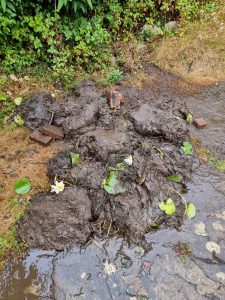
How Do I Keep Leaves Out of My Pond in the Autumn? Effective Strategies for a Clean Water Feature
Autumn brings beautiful colours, but also falling leaves that can clutter your pond. Keeping leaves out of your pond is important for maintaining water quality and protecting your fish and plants.
You can keep leaves out of your pond by using pond netting, regularly skimming the surface, and trimming nearby trees and plants. These methods are simple but effective ways to prevent leaf build-up and keep your pond healthy.
A clean, leaf-free pond looks better and requires less maintenance. By taking steps to keep leaves out, you’ll spend less time cleaning and more time enjoying your pond throughout the autumn months.
Understanding the Impact of Autumn Leaves on Your Pond
Fallen leaves in your pond can cause issues if left unchecked. They affect water quality and may harm fish and plants if not managed properly.
The Risks of Decomposing Leaves
When leaves fall into your pond, they start to break down. This process uses up oxygen in the water, which can be bad for fish and other pond life.
As leaves rot, they release nutrients. These can feed algae, leading to green water. Too many nutrients can also upset the balance of your pond’s ecosystem.
Decomposing leaves can clog filters and pumps. This makes it harder to keep your pond clean and healthy. A thick layer of leaves on the bottom can also create muck, which is hard to remove.
Maintaining Water Quality in Autumn
To keep your pond healthy in autumn, remove leaves often. Use a net or skimmer to catch leaves before they sink. This helps keep the water clear and reduces the workload on your filter.
Check your pond’s pH and oxygen levels regularly. If you notice changes, take action quickly. Adding a pond aerator can help boost oxygen levels, which is good for fish and plants.
Consider using a pond vacuum to remove any leaves that have sunk to the bottom. This prevents a build-up of organic matter and keeps your pond cleaner.
Trim back nearby plants to reduce the number of leaves falling into your pond. This makes autumn maintenance easier and helps protect your pond’s water quality.
Pre-Autumn Pond Preparation
Getting your pond ready before autumn arrives is key to keeping leaves out. Taking action early helps protect your pond and makes maintenance easier later on.
Assessing Your Pond’s Needs
Start by looking at your pond’s surroundings. Count how many trees are nearby and note their types. Deciduous trees lose leaves in autumn, while evergreens shed year-round. Check the wind direction to see where leaves might blow from.
Look at your pond’s shape and size. A larger surface area needs more protection. Odd shapes may require custom solutions. Check your filtration system and skimmers. Clean them out and make sure they’re working well.
Consider your fish and plants. Some may need special care as the weather cools. Write down what you’ll need to do for them in the coming months.
Installing a Pond Net Early
Put up a pond net before the leaves start to fall. This is often in early to mid-September. Choose a net with small holes to catch even tiny leaves. Make sure it’s strong enough to hold wet leaves without sagging.
Measure your pond carefully. Buy a net that’s a bit bigger than your pond. This gives you room to secure it properly. Set up supports around your pond to hold the net above the water. Use stakes, poles, or a frame.
Stretch the net tight over your pond. Secure it well at the edges. Leave some slack so it doesn’t touch the water. Check the net often and remove leaves as they collect.
Regular Pond Maintenance During Autumn
Keeping your pond clean during autumn requires consistent effort and the right tools. A daily routine and proper equipment can help manage falling leaves and debris effectively.
Daily Inspection and Cleaning
Check your pond each day for fallen leaves. Remove them quickly to prevent water quality issues. Use a long-handled net to scoop out leaves and twigs from the surface. Pay extra attention to areas where leaves tend to gather, like corners and around plants.
Clean your pond filter regularly. Autumn brings more debris, so your filter may need more frequent cleaning. Rinse filter media in pond water to preserve beneficial bacteria. Keep an eye on water levels and top up if needed.
Trim dead or dying plants around the pond. This reduces the amount of plant matter that can fall into the water. Remove any algae you spot to keep the water clear.
The Role of a Pond Skimmer
A pond skimmer is a key tool for autumn pond care. It sits at the water’s edge and pulls in surface debris. The skimmer basket catches leaves before they sink. Empty the basket daily or more often if needed.
Check the skimmer’s pump regularly to ensure it’s working well. Clean the skimmer box weekly to prevent blockages. A well-maintained skimmer can greatly reduce your daily cleaning work.
Some skimmers have a fine mesh that catches smaller particles. This helps keep your water clearer. If your skimmer has this feature, clean it more often to maintain its effectiveness.
Utilising a Pond Vacuum
A pond vacuum is useful for deeper cleaning. It removes debris from the bottom of your pond. Use it every few weeks to suck up sunken leaves and sludge. This prevents the build-up of harmful gases from decaying matter.
Choose a vacuum with different attachments. This lets you clean various areas of your pond effectively. Some vacuums can also perform water changes, which is helpful for maintaining water quality.
Be gentle when vacuuming near fish and plants. Move slowly to avoid disturbing the pond’s ecosystem. After vacuuming, check your pond’s water chemistry. Add beneficial bacteria if needed to help break down any remaining organic matter.
Additional Pond Care Techniques
Proper pond care goes beyond leaf control. These methods help keep your pond healthy and balanced year-round.
Manual Leaf Removal
A pond net is a key tool for removing leaves. Skim the surface daily to catch leaves before they sink. For sunken debris, use a long-handled net to scoop it out. Pay extra attention to shallow areas where leaves tend to gather.
Empty skimmer baskets often to prevent overflow. A pond vacuum can help with stubborn build-up on the bottom. For larger ponds, waders let you get in and remove leaves by hand.
Don’t forget to check around water features and plants. Leaves can hide in these spots and decay if left unchecked.
Balancing Pond Ecology
A well-balanced pond fights algae growth naturally. Add beneficial bacteria to break down organic matter. These microbes eat excess nutrients that algae would otherwise use.
Plants play a big role in pond health. Water lilies shade the surface, cutting down algae. Oxygenating plants like hornwort release oxygen into the water.
Test your water regularly. pH levels between 6.8 and 7.8 are ideal for most pond life. If needed, use pH adjusters to maintain balance.
Consider adding a UV clarifier to your filtration system. It kills algae spores as water passes through, keeping the pond clear.
Considering Pond Heating Solutions
As autumn turns to winter, pond heating becomes important for keeping fish healthy. Pond heaters can maintain water temperatures above freezing.
There are a few types of pond heaters to choose from:
- Submersible heaters
- Floating de-icers
- In-line heaters
Submersible heaters sit at the bottom of your pond. They warm the surrounding water, creating a warm zone for fish.
Floating de-icers float on the surface. They keep a small area ice-free so gases can escape. This prevents toxic build-up under ice.
In-line heaters attach to your pond’s filtration system. They heat water as it passes through.
When picking a heater, consider your pond’s size and depth. Larger ponds need more powerful heaters. Deep ponds may need multiple heaters at different levels.
Look for heaters with thermostats. These turn on only when needed, saving energy. Some have freeze protection settings to prevent ice formation.
Place heaters away from plants and liner edges. This prevents damage from concentrated heat.
Check heaters regularly in winter. Remove any ice build-up. Ensure they’re working properly to keep your fish safe.
After Autumn Pond Care
Autumn leaves have fallen, but your pond care duties aren’t over yet. These tasks will keep your pond healthy through winter and ready for spring.
Post-Autumn Cleanup
Start by removing any remaining leaves from your pond’s surface. Use a long-handled net to scoop out debris. Check the bottom of your pond for settled organic matter. A pond vacuum can help remove this sludge.
Trim back dead or dying aquatic plants. Cut them to about 2 inches above the water line. This prevents excess decomposition in winter.
Check your pond’s water level. Top it up if needed before cold weather sets in. This protects fish and equipment from freezing temperatures.
Test your water quality. Adjust pH and other parameters as needed. This keeps your fish healthy during their winter dormancy.
Evaluating and Repairing Equipment
Inspect your pond pump, filter, and UV clarifier. Clean or replace parts as needed. If you plan to run equipment through winter, ensure it’s in top shape.
Check for leaks in your pond liner. Repair any holes or tears you find. This prevents water loss and damage during freeze-thaw cycles.
Consider adding a pond de-icer or aerator for winter use. These tools keep a small area ice-free, allowing toxic gases to escape.
Store unused equipment properly. Clean it thoroughly and keep it in a dry place. This extends its lifespan and ensures it’s ready for spring.



